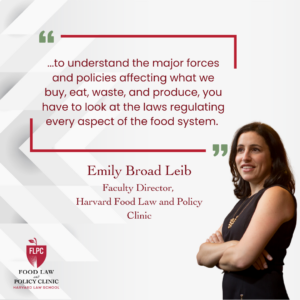This article was originally written by Liz Mineo and published in The Harvard Gazette on August 16, 2021.
Every year, nearly 700 million people suffer from hunger around the world, while 1.3 billion tons of food are thrown away. Both food waste and hunger have increased during the pandemic.
It doesn’t have to be that way, said Emily Broad Leib, director of the Food Law and Policy Clinic of the Center for Health Law and Policy Innovation at Harvard Law School. The Gazette interviewed Broad Leib about the ways in which food donation could help the fight against hunger as well as climate change.
Q&A
Emily Broad Leib
GAZETTE: How did you get interested in the subject of food law?
BROAD LEIB: When I went to Harvard Law School, my focus was international human rights. After Law School, I did a fellowship in community development in rural Mississippi, and one of the first projects I worked on was legal training for local farmers and farmers markets. They wanted to grow foods, but they didn’t know what they were allowed to sell. Everything grew from there. There is a huge change around what people want the food system to do. For a lot of the 1900s into the early 2000s, the idea was just that food appears at the store; we buy it; and we bring it to our house. Now people are thinking a lot more about what’s in our food, how it is impacting us, what it is doing to the environment, where it is coming from, and who the workers are who produce this food. A lot of fields are implicated in this, but law has a lot to say in how we answer questions about our priorities, the transparency in the food system, and who are the winners and losers.
GAZETTE: How can food donation help the fight against hunger?
BROAD LEIB: Prior to COVID, there were about 690 million people globally living in hunger, according to the U.N. Food and Agriculture Organization. Estimates are that, because of COVID, that increased to between 720 to 811 million people, and rates of extreme hunger have also gone up. There are a lot of factors causing hunger. A big piece relates to economics and well-paying jobs, but hunger also is a day-to-day need, and long-term solutions, while they’re necessary, can’t resolve the day-to-day problem that people are facing. There is a movement to think about the right to food, which a lot of countries recognize, as one that includes the right to not have food go to waste. We put a lot of energy into producing that food, and the best thing that we can do is make sure that it goes to someone who is in need. In the U.S., there is data that shows that reducing the amount of food that we waste by just a third could feed all the food-insecure people in this country. There is nothing worse than thinking about people being in hunger while watching surplus food rot in the field or get thrown into a dumpster.
GAZETTE: What are the obstacles in the law that prevent food donation?
BROAD LEIB: There are two sides to it. On one side, there are actual legal and policy barriers to donating, and they can be real or perceived. As an example of a perceived barrier, in the U.S., we don’t mention food donation in any of our food safety laws. We’re strict about food safety; almost everything is regulated but so often food is wasted because it’s not clear what can you do with the food, whether it is allowed to be donated or not.
In some countries, there are real barriers to donating food. In our research, we found that in some countries, there is a tax penalty for donating food instead of throwing it away. This happens in Argentina. In general, businesses that acquire food have to pay a value added tax [VAT] and can recover that money from the consumer. In Argentina, when you throw food away, you can claim a credit from the government for the VAT that you paid, but when you donate food, you can’t claim that same credit. There is a real economic penalty to donating versus throwing it away.
On the other side, there is a lack of incentive to donate food. In many countries, there is no tax benefit, or if there is, it’s very low. Also, it’s not necessarily cost-effective to donate food because you need to treat it carefully, have extra space in your freezers and trucks to transport it, and you need to train workers. Thinking about food coming from the farm, in the U.S., recent estimates say that we probably waste 13 million tons per year of food on the farm that doesn’t get harvested because either it’s not up to the aesthetic standards or the farmer met their goal for the contract and there’s extra that they just don’t need. There is a cost associated with harvesting and transporting that food, and if you can’t make the numbers work for businesses, it’s hard to say to them that we want them to spend all this money and time doing what’s good for society if that’s not actually going to make economic sense for them.
Part of our work has been to explore the different categories of barriers and the universal issues that people bring up when it comes to food donation. That has been our work in the Global Food Donation Policy Atlas, a project we conduct in partnership with the nonprofit Global FoodBanking Network that maps barriers and best practices to food donation around the world.
GAZETTE: What are the main findings of this atlas?
BROAD LEIB: In the first year, we picked a range of five countries (out of our initial list of 15) to look at the universal issues surrounding food donation. Now we’re looking at a broader set of countries to compare their policies and see who has the best practice or the best policy on various areas related to food donation. The atlas is trying to answer those questions and help users identify the very strongest model laws, while giving also specific useful tools to each individual country. For each participating country, we include a detailed legal guide of their current laws that food banks or food donors can use right now to find out what is allowed and what is not. There are recommendations for what are the top few changes, based on our conversations with our food bank partners, governments, and businesses, that really need to happen to make food donation more of a habit rather than being taboo or something that only happens occasionally.
GAZETTE: How do U.S. food donation policies compare to other countries in your atlas?
BROAD LEIB: When we first started the project, we thought the U.S. could strengthen its own policies, but when you look around the world, there are areas where we might be better off than other countries. It doesn’t mean that we have it right 100 percent. There are areas where we’re behind, such as date labeling on food products. We have all the resources and the capability of making those dates clear and comprehensible, and we’re just not doing it. The EU is blowing us out of the water; the U.K. has clear standard labels on food and guidance documents for consumers, businesses, and food banks about how foods can be eaten after the expiration date or can be donated. They’re light years ahead of us. But in terms of tax incentives for food donors, we have the most generous of any country. Food donors in the U.S. can get a very good incentive when they donate food, and that could be an example for other countries to follow. Over time, we’ll add more countries to the atlas, but even now you can get a good idea on where the hotspots are, where we’re doing well, and where we can make progress.
GAZETTE: How much of the food produced in the U.S. is donated?
BROAD LEIB: Studies estimate that between 7 and 10 percent of the U.S. surplus food gets donated. The rest of the surplus food goes to landfills; some to combustion, which is incinerated. There is so much edible food that is getting thrown away. It’s so disheartening. If you go behind any store and look in its dumpster, a large majority of what is in there could be in my refrigerator right now.
GAZETTE: How can food donation help the fight against climate change?
BROAD LEIB: The U.N.’s Intergovernmental Panel on Climate Change [IPCC] put out a report 18 months ago about food production and climate change, in which they found that about 8 to 10 percent of global anthropogenic emissions come from food waste. That is a sizable amount. There are lots of other places where we can reduce emissions, but it’s going to be tricky because those emissions meet other needs; we need electricity, energy. Reducing food waste seems to be one of those areas that is a win-win situation. No one is benefiting when we throw food away. The production of food itself causes emissions, and when the food goes to the landfill, it’s a huge emitter of methane. So that’s not good on either end of it.
GAZETTE: What is the impact of COVID on hunger and food waste?
BROAD LEIB: Hunger has increased because of COVID but so has food waste. In a lot of cases, it’s because certain supply chains got shut down. Food that typically goes to hotels or restaurants — and this also happened in the U.S. — suddenly had to be wasted because nobody knew where to send the food, and our supply chain wasn’t flexible enough to get all that food to grocery stores or food pantries. Feeding America, the network of food banks in the U.S., has seen an increase of need for food bank services, and that 75 percent of the people knocking on their doors were first-time users of food banks. Much of the food that goes to waste is totally fine and edible and it gets wasted because of log jams in the marketplace or confusion over date labels.
GAZETTE: What would you like to see happening in the landscape of food donation policies?
BROAD LEIB: We’ve already seen a lot more awareness about these topics and I think that will manifest in both being more thoughtful about food waste and food donation, but also around treating the land and workers in the food supply better. Every meal that we eat is magical when you think about how all these things came together, and they’re all only renewable resources if we treat them with respect, including the workers. My hope is that we’re moving toward a direction where there’s more respect for all the ingredients in the food system.
I’ve done a lot of research domestically around law school teaching and scholarship on food systems, and I’m doing a project now looking at teaching in law schools globally in this field. I think there is a real opportunity for learning and collaboration about these issues amongst lawyers. My hope is also that there are more active partnerships across countries on not just food donation, but on other food policy issues as well. At this point, more than 25 students from Harvard Law School have been involved in the atlas, and I wanted to acknowledge that. Part of my hope is that we’re training thoughtful leaders in this space who can evolve and build on this work in the future.
This interview has been condensed and edited for length and clarity.


Health Law & Policy, Commentary
Braidwood Management v. Becerra: Updated FAQs for Health Advocates and Providers
July 22, 2024